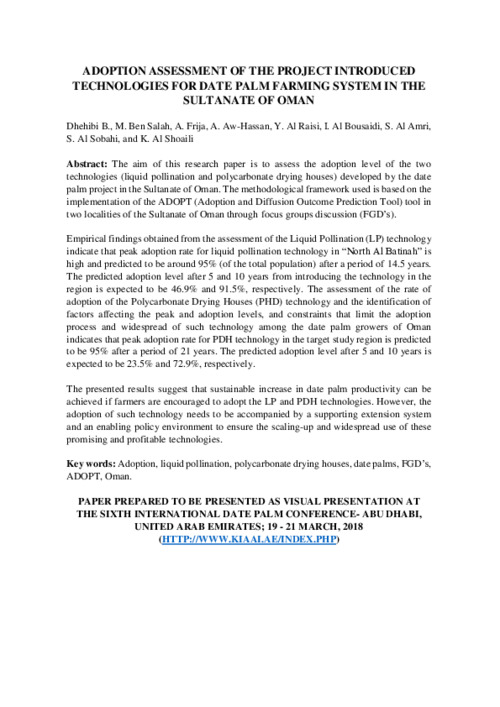Adoption assessment of the project introduced technologies for date palm farming system in the Sultanate of Oman
Abstract
The aim of this research paper is to assess the adoption level of the two
technologies (liquid pollination and polycarbonate drying houses) developed by the date
palm project in the Sultanate of Oman. The methodological framework used is based on the
implementation of the ADOPT (Adoption and Diffusion Outcome Prediction Tool) tool in
two localities of the Sultanate of Oman through focus groups discussion (FGD’s).
Empirical findings obtained from the assessment of the Liquid Pollination (LP) technology
indicate that peak adoption rate for liquid pollination technology in “North Al Batinah” is
high and predicted to be around 95% (of the total population) after a period of 14.5 years.
The predicted adoption level after 5 and 10 years from introducing the technology in the
region is expected to be 46.9% and 91.5%, respectively. The assessment of the rate of
adoption of the Polycarbonate Drying Houses (PHD) technology and the identification of
factors affecting the peak and adoption levels, and constraints that limit the adoption
process and widespread of such technology among the date palm growers of Oman
indicates that peak adoption rate for PDH technology in the target study region is predicted
to be 95% after a period of 21 years. The predicted adoption level after 5 and 10 years is
expected to be 23.5% and 72.9%, respectively.
The presented results suggest that sustainable increase in date palm productivity can be
achieved if farmers are encouraged to adopt the LP and PDH technologies. However, the
adoption of such technology needs to be accompanied by a supporting extension system
and an enabling policy environment to ensure the scaling-up and widespread use of these
promising and profitable technologies

